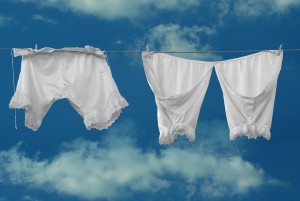7 Interesting Facts About Underwear

Underwear has not always been worn and the styles have changed many times through the years (though many may argue that going from loincloths the thongs have almost taken us full circle). Let’s take a look at some interesting fact about those items of clothing most of us wear, but not many talk about.
- The average British woman owns 34 pairs of underwear. American ladies own 21. Men own an average of five to eight. It’s not just that women buy more underwear, but women tend to hang on to them once they are purchased. Fifteen percent of women own underwear that is five to ten years old. Ten percent of men have underwear that has been in service for over a decade. Men tend to buy sets that are practical. Women will buy several sets and keep a few stashed away for special occasions.
- Just because underwear is owned it doesn’t mean they are worn. A survey of French men revealed that only 60 percent change their underwear daily. French women were a little better at 75 percent. On average, British men changed their skivvies more often than French men or women at 78 percent, but even they lagged well behind British women with 95 percent changing their unmentionables each morning. Americans fall in between the British and the French. A 2011 survey by Clorox found that nearly 15 percent of men wear their underwear two to three times between washes On the whole, married people tend to change their underwear more than single people, though not much more: 88 percent to 82 percent.
- The average pair of clean underwear contains feces. Charles Gerba, a professor of microbiology at the University of Arizona said, “There’s about a tenth of a gram of poop in the average pair of underwear.” Further, bladder leakage is common among women who have had children and in many middle-aged men. Washing machines don’t clean them out because the water is not hot enough and the detergents cannot kill the bacteria. According to ABC news, “If you’re not using bleach or very hot water, you’re not killing the bacteria — they’re getting on your hands and staying in the washing machine.” If this is not a reason to frequently buy and change out your underwear, what is? With the incredible prices on name brands through clothing discounters like The Adair Group, there is no reason to forego new purchases, either.
- The 1920’s and 1930s introduced major changes to the underwear market. The “flappers” of the 1920s started wearing decorative and more “risque” undergarments. These evolved into the clothing we currently call “lingerie”. In the 1930’s, the corset was advanced by the advent of new materials. The new body shaping clothing was known as the “girdle”. Because the girdle created a small waist by tightening from below instead of constricting the ribcage, it provided women with an hourglass figure without the dangers associated with the corset.
- Major advanced in the underwear market took place in the 1950s. The creation of spandex and rayon made many new styles and concepts of underwear possible. For the first time, underwear started to become expressive and not just pragmatic. The 1950s also saw innovation from the Pacific islands make its way into the underwear market. The bikini brief was born. Not only did this new cut and style revolutionize the industry, it is the most popular style of underwear to this day.
- Speaking of preferences, men prefer to wear briefs. In fact, 41 percent choose briefs (including the bikini cut brief), 7 percent favor boxers, and 32 percent wear thongs, other variations, or nothing at all. For women, 37 percent prefer bikini briefs, 23 percent favor briefs, 19 percent choose thongs, 17 percent like boyshorts, and 4 percent prefer other underwear styles.
- Euromonitor data showed the global underwear market in 2014 was worth just over $110 billion. The vast majority of this was women’s underwear. According to the NPD group, “The men’s underwear bottoms market reached $2.7 billion and grew 3 percent in the 12 months ending September 2014.” What this really means is that we don’t need to be re-wearing our underwear. It also means that we are spending way too much on our skivvies. Many types, brands, and variations of quality underwear can be purchased for pennies on the dollar at clothing discounters like The Adair Group.
If you survived the underwear facts, congratulations. Now it’s time to act on the information. Don’t be one of those who feels the need to wear the same pair of drawers repeatedly or feels compelled to wear underwear of a type or style that is not to your liking.


